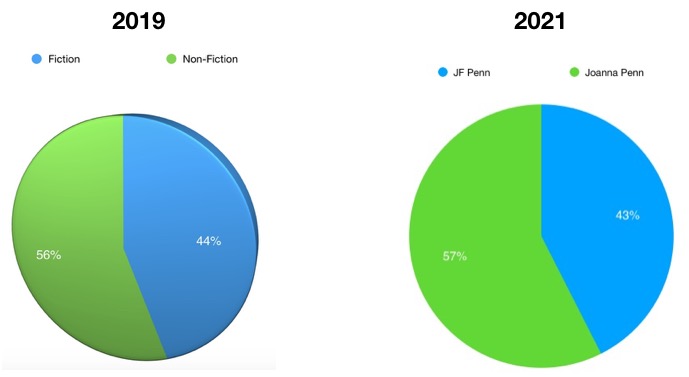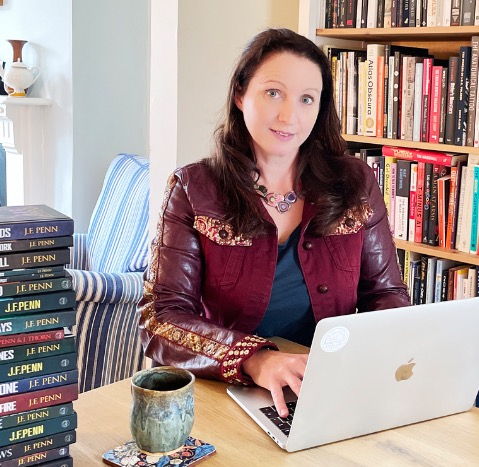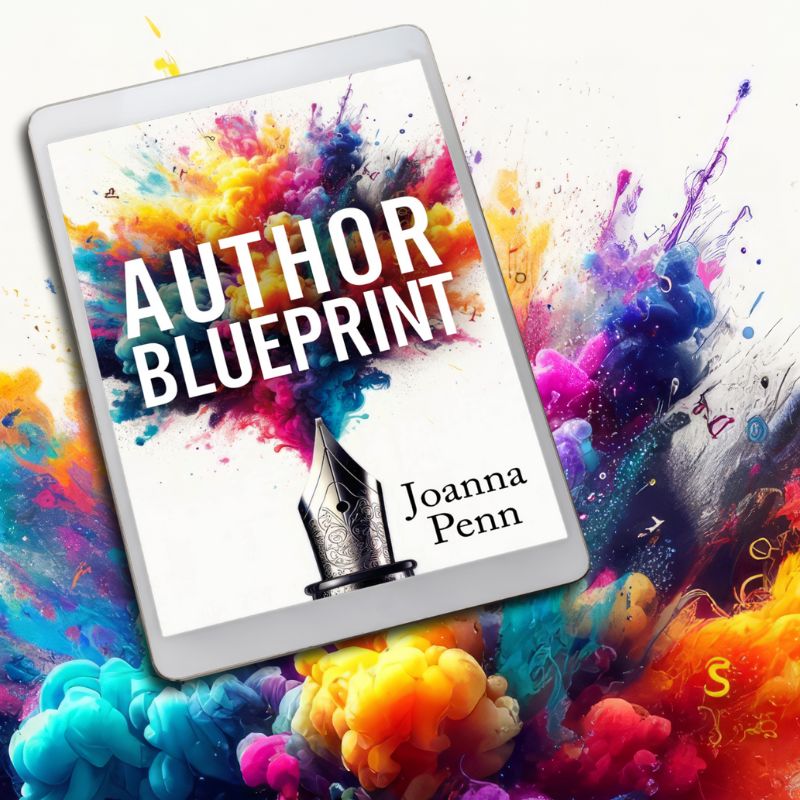It's the time of year when I break down my book sales and hope that my own insights are useful for you, wherever you are on the author journey.
Of course, beware comparisonitis. If I compare myself to some authors, I am doing very badly, and if I compare myself to others, I am a rockstar! Definition of success is an individual thing, and results will vary based on genre, number of books, business models, marketing spend and more. So please just take this as data for interest, not comparison.

I didn't do a report in 2020 because we were in the depths of pandemic lockdown, so I will compare figures to 2019. You can also see more reports over the years on my Author Timeline. My tax year runs May – April, so this is May 2020 – April 2021.
Multiple streams of income
My overall revenue for book sales was up. As has been reported in many places, the pandemic has driven more readers online, and many indie authors benefitted from having an established digital, online business model.
My book sales revenue was just a little over six figures in GBP, but importantly, book sales are not my only income streams. They made up 34% of my company income in the last tax year. I have 15 non-fiction books as Joanna Penn and 19 novels and novellas plus short stories. [Note: I also publish my mum's sweet romance under Penny Appleton but those figures are not included.]
There are lots more ideas for how you can make multiple streams of income in How To Make A Living With Your Writing — my other streams (affiliate income, courses, podcast sponsorship and patronage) are driven by writing on my blog and podcast.
Revenue split by vendor

I am pretty happy about this revenue split. Amazon still retains a big share but it is decreasing.
Audiobooks have clearly increased, with Findaway going from less than 1% of revenue to 5%, and excitingly, my direct sales have grown from 1% to 6%. This is where I want to continue to focus my efforts.
Yes, you can buy my ebooks and audiobooks direct at Payhip.com/thecreativepenn! Get 50% off with coupon: JULY21 (up to the end of July 2021) Here's how to use the coupon.
Revenue split by format

This is the first year I have included hardbacks and large print in my print breakdown, but print is a smaller share of total revenue, while audiobooks have increased again.
The audio boom has been much discussed and in my case, audio sales are cannibalizing non-fiction print books, rather than ebooks.
Revenue split by author brand: Joanna Penn and J.F. Penn

This is almost exactly as it was in terms of % split, which is interesting. In terms of ad spend, I did have a couple of months experimenting with both fiction and non-fiction advertising before settling on a few basic things.
For non-fiction as Joanna Penn, I outsourced my Amazon Ads (through Reedsy) but the main marketing comes from this site and my podcast.
For fiction, I use sporadic BookBub PPC ads to the permafree first in series (Stone of Fire) and discounted first in series (Desecration and Map of Shadows), as well as applying for Kobo and Apple promotions on boxsets.

I tried some Facebook Ads and Amazon Ads for my fiction last year, but although it did result in increased sales, I hated doing it, so I gave up. Life is too short to do things you don't enjoy!
So although I ramped up ad spend for a few months, it is now back to a reasonable amount, around 10-20%, depending on the campaign. I still prefer content marketing when people pay me to advertise and not the other way around!
Fiction / non-fiction split by vendor

(Sorry for the differences in labelling!)
As previously, I sell more fiction at Apple, Kobo and Google, mainly because it's easy to market a free or discounted first in series, and fiction box-sets do really well.
I'm encouraged by the growth in fiction print books at Ingram Spark and also fiction ebooks & audio through Payhip, as that was negligible in 2019 (marked as Direct).
The message on buying direct from authors is beginning to filter through, and the more of us who do it, the more we can educate readers to support creators directly. I have a tutorial on selling ebooks and audiobooks direct through Payhip and Bookfunnel, if it's something you're considering.
Ebook sales revenue by country

Last tax year, I sold ebooks in 126 countries — and in total, since 2008, I have sold ebooks in 166 countries, primarily in English. [Note, only ebook sales are included as reporting is sketchy for territorial markets for print and audio.]
This makes me very happy! But of course, most of the sales are the major markets of US, UK, Canada and Australia, and the rest are a very long tail. My US and UK sales have increased which could be explained by ease of advertising to those markets, and also the fact that most of my direct sales are also in these markets as they are more used to buying online.
What action will I take in the next year?
I want to continue writing the books I want to write, and focus on growing my direct sales — which I think is just a matter of education for both authors and readers. You can read about the benefits of direct sales here.

After almost a decade doing this full-time, I think I am finally ready to accept who I am as a writer because I'm actually pretty happy with this round-up!
I will never be a high-volume writer in one targeted genre. I will never write to market. I will never be an expert in paid ads. And that's OK!
We are all different and indie is a broad church with many routes to becoming an author-entrepreneur — if that's even what you want. Most authors (happily) keep their day jobs and/or don't do it for the money. You get to choose your path and no way is better than any other.
Have you done a book sales breakdown? Did you learn anything or are you going to change anything? Please feel free to comment or ask a question — but remember, no comparisonitis!
Thanks to Robin at AuthorHelp for doing my mega-data-spreadsheet. There are still no tools that manage all wide sales. You can use ScribeCount for the main ebook stores and BookReport is still good for KDP, but otherwise, you have to do spreadsheets!



“I will never be a high-volume writer in one targeted genre. I will never write to market. I will never be an expert in paid ads. And that’s OK! ”
I need to add this quote as a motivational poster on my wall!
Thanks for the breakdown. I really enjoy these types of posts.
I loved that too! Good idea about making it a motivational poster. Be who you are, not what others say you should be.
Thank you everything as always dear Joanna! Inspiration for years you are .-)
Thanks, Julia!
Thanks for sharing Joanna!
It is great to see such a detailed split and gives me hope that the quick release model isn’t the only path to success. I really appreciate the information that the Indie author community continues to share.
Your business model is definitely more suited to the kind of life I am trying to set up.
It’s definitely about lifestyle 🙂 I have never rapid released anything!
Thank you for sharing this. I love that you are happy where you are. All power to your elbow ( or maybe that should be computer!). And thanks for the podcasts too, they’re great.
Totally agree re the need to educate readers to buy direct from authors – but I also need to educate myself in ways to encourage that!
I understand why you love going wide, but I’m just starting out and by using Select days in combo with Freebooksy (this month I am learning BookBub) I am seeing substantial read-through with my series. Truth be told, KU page reads are a real dopamine hit for me every month as page reads grow. I am learning Amazon ads but just got spanked hard with Facebook ads, a very expensive lesson before I pulled the plug mid-month. None of what I just said would have been possible without your non-fiction books and weekly podcast over the years. You turned me on to Draft2Digital for my BoxSets, Reedsy for editing and cover design, ProWritingAid, Vellum, and, Mark Dawson Thank you for all you do, Joanna.
Hi John, You know I am absolutely fine with people choosing KU 🙂 Whatever works for your books and your situation.
You have always taken action on things and tried new angles, so I am so glad to be part of your author journey!
Joanna, thanks for the encouragement and the great stats. These were quite meaningful. I just created my own store through Aerio and I hope to develop it to counter Amazon.
Hey Joanna,
Whoa, girl! You’re kicking Internet ass! 🙂
I tried to sign up for ScribeCount, but can’t seem to get it to work.
Anyway, carry on! 🙂
Cheers,
Debbi
Joanna, I struggled my whole life for the right path to live my ikigai as a writer, filmmaker, and speaker. You are showing me the business side of the path that has always been the missing part after all my fancy degrees, training, conferences, trying and failing. Forever grateful.
I don’t even know how many hundreds of thousands of people have paid with their time, attention, and cash to listen to and read what I have to say, but I know I’ve hardly ever seen any of it. For a guy who is a professional real estate investor, which is another way to say professional negotiator, I may have missed a few key things. Learning from you and think I have listened to all your nonfiction books in the last two weeks, several of them twice.
I probably owe you some money as I started on Audible paying for each one individually, then you told me a about Scribd.
I’m glad to help, Sandor! I still get some money through Scribd 🙂 I’m glad you’re finding the books useful.
So inspiring! I haven’t written any fiction books yet, (three non-fiction) but you are definitely my guru for writing! And by the way, your generosity is astounding. Truly a wonderful spirit. Thanks so much for all you do!
Tesia
Joanna:
What I am wondering on your income breakdown is how much of your overall income comes from your fiction vs. your nonfiction percentage wise, and has this changed historically with your writing to a significant degree? (I imagine it would have changed a lot if you focused on one type over the other earlier in your career)…
For instance, do you make say around 30% of your income from fiction vs. 70% from nonfiction or something similar?
And also, what would tie into this is how much time you put into one vs. the other? Is it a general 50/50 split or do you spend, for instance, far more time completing your novels vs. nonfiction books? It would also be skewed of course if you had far more books in one category published than in another…
As an author trying to get started publishing, the general trend of advice I hear is that its much easier to sell nonfiction than fiction…
Thanks!
Hi Ray, I included that split — it’s 3rd on the list, Revenue by author brand which is fiction/non-fiction, and I have shared that every time. You can see historical reports here — https://www.thecreativepenn.com/timeline/
In terms of time, I couldn’t tell you. I don’t track it at that level, but I tend to just oscillate between writing fiction and non-fiction.
It is much easier to sell non-fiction – IF you have an audience, and IF you’re writing on a topic people are interested in with easy to reach keywords — but if your passion is fiction, then write that. Or write everything, as I do. This is a long term career, you can do it all, just not at once!